This gluten-free shortbread recipe makes cookies that are rich and flavorful. They’re not too sweet and the texture is wonderful: slightly crumbly in the best way. The cookies are egg-free and can be made dairy-free.
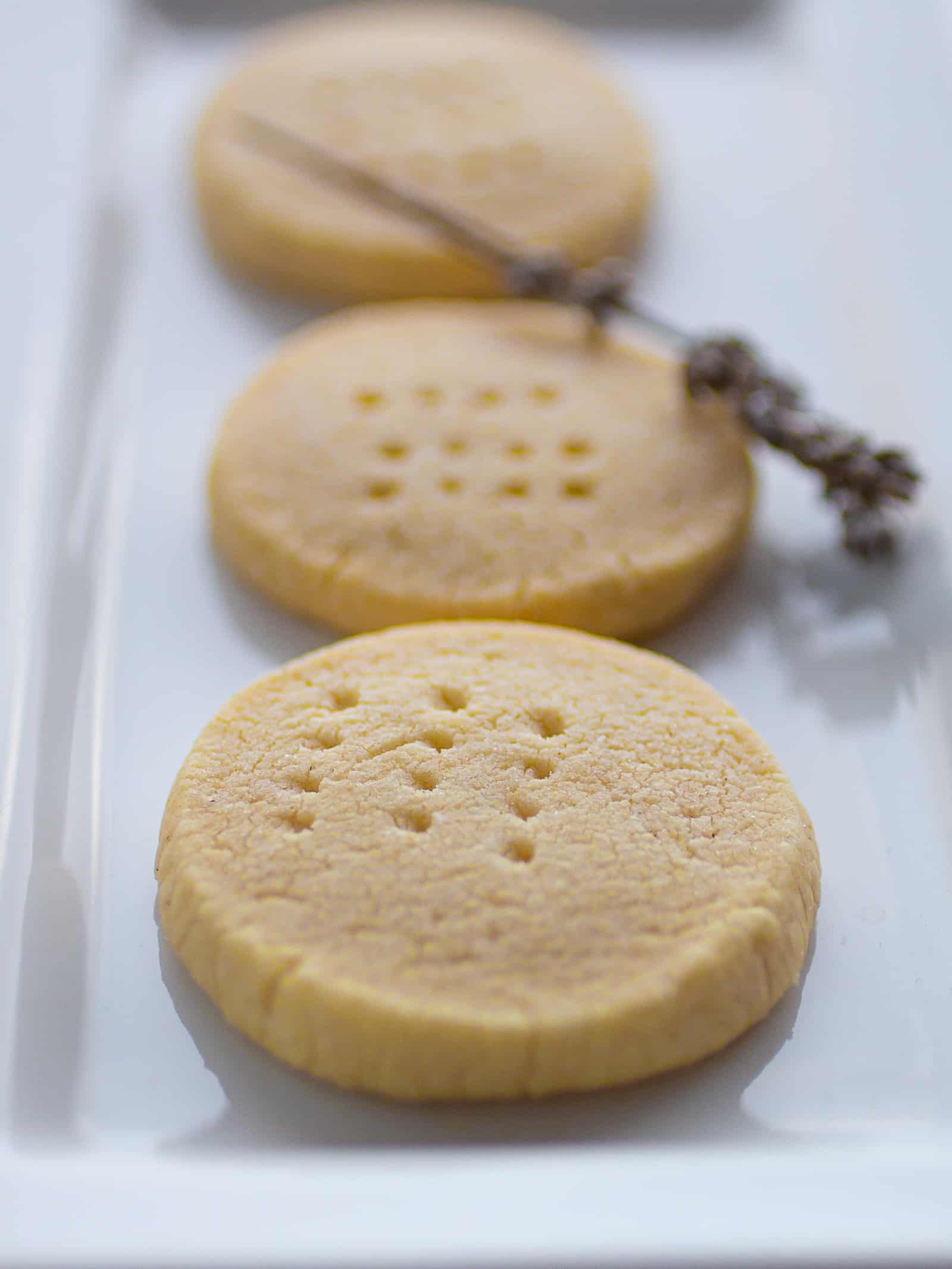
Gluten-free shortbread cookies are rich, buttery, and only require five ingredients to make. Unlike classic gluten-free sugar cookies, shortbread is naturally egg-free. The butter and vanilla are the real stars of the show here. The dough contains just enough gluten-free flour to hold everything together.
Some classic recipes for shortbread contain rice flour. This means the texture of a gluten-free shortbread cookie is very similar to its wheat counterpart. It’s crisp and delicate.
Since the basic recipe is so simple, it welcomes variations. I’ve included a few of my favorites but feel free to play around with this recipe.
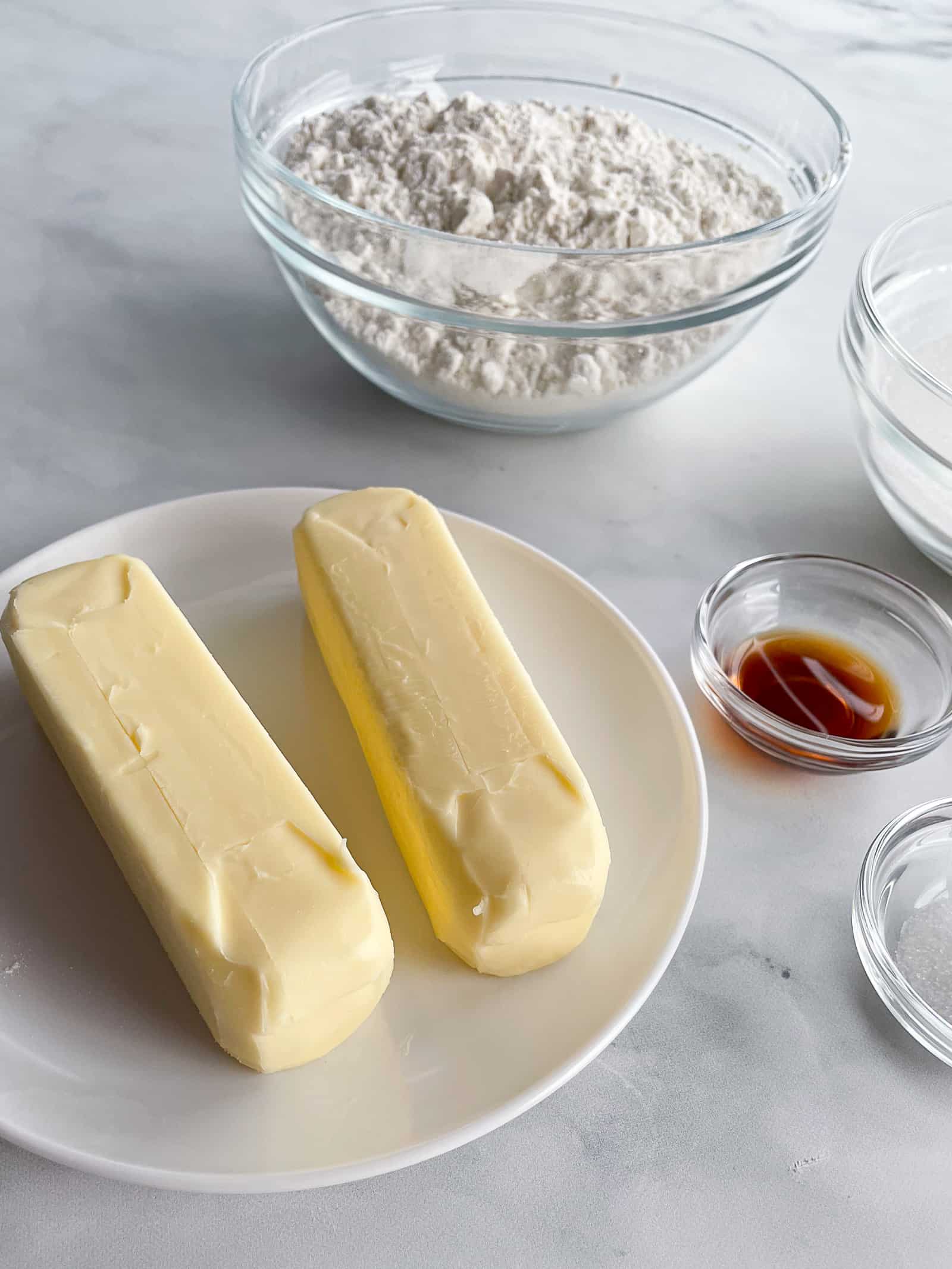
Key Ingredients.
- Gluten-Free Flour. A gluten-free flour blend helps the cookies hold their shape during baking. Look for a blend that contains xanthan or guar gum. (If your blend doesn’t, whisk ¼ teaspoon into the gluten-free flour before using.)
- Butter. Butter is an essential ingredient in shortbread cookies. It gives the cookies flavor and a rich texture. Both salted and unsalted butter work in this recipe but butter is my preference. The salt gives the cookies a deeper flavor and helps to balance the sugar. For gluten-free and dairy-free shortbread cookies, use your favorite dairy-free butter. (See note below for information on gluten-free and dairy-free shortbread cookies.)
- Granulated Sugar. Shortbread’s delicate sweetness comes from granulated sugar. Don’t use maple syrup or honey in this recipe or the cookies will spread.
- Vanilla Extract. A teaspoon of vanilla extract adds flavor.
- Salt. Use fine (table) salt. It blends easily and evenly into the dough. If you only have flaky Kosher salt in the house, increase the salt to 1 ½ teaspoons.
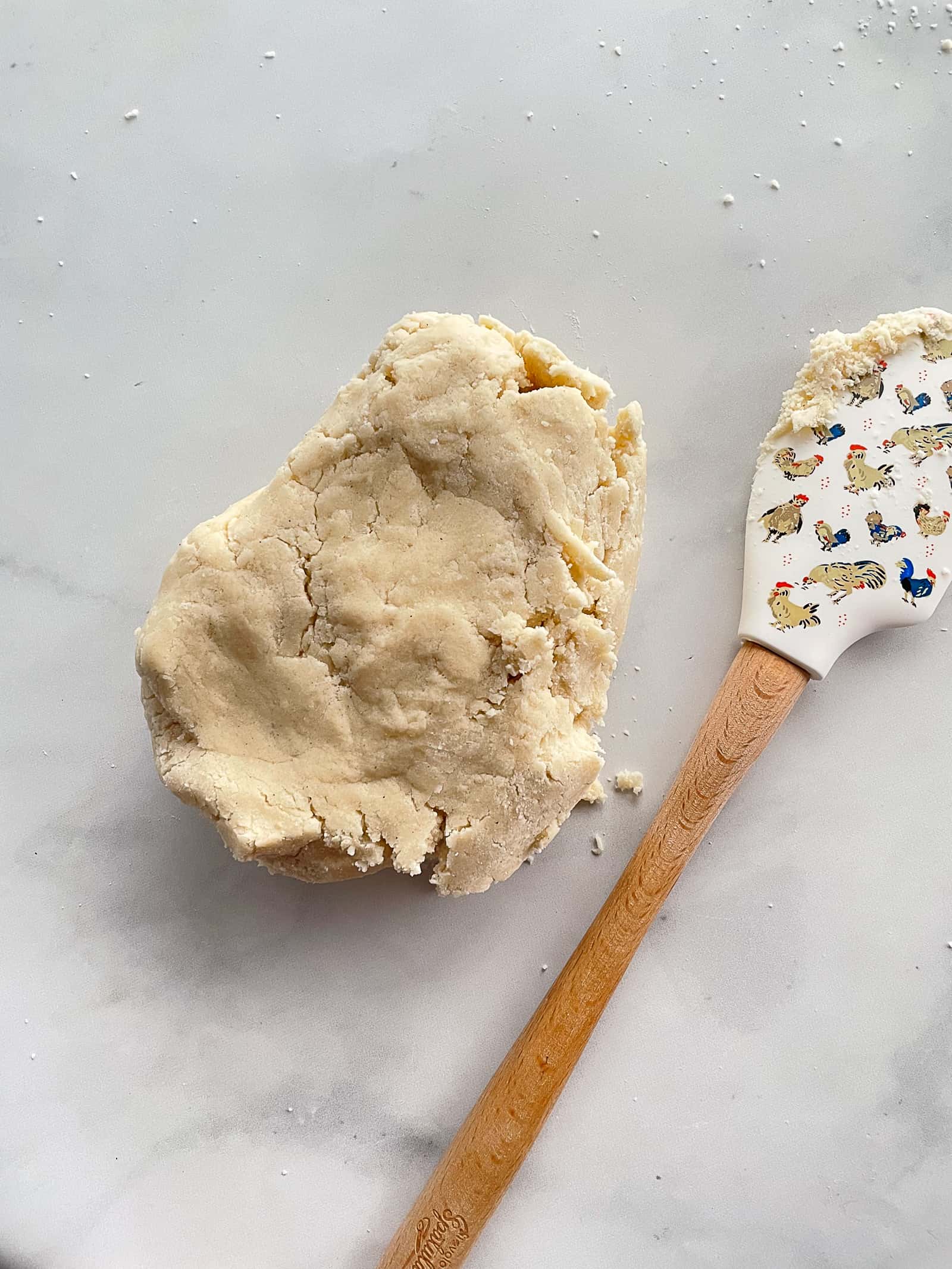
How to Make Gluten-Free Shortbread Dough. Steps for Success.
Gluten-free shortbread is a little tricky to make. Since it lacks liquid, sometimes the dough can be crumbly. Here’s how to make the perfect gluten-free shortbread dough every time.
1. Start with Softened Butter.
The most important step in this recipe is using softened butter. Aim for it to be about 65 to 68℉. You want the butter to feel cool to the touch. If you poke it, look for the butter to give a little resistance but not crack.
If the butter is too cold, the shortbread dough won’t come together. If the butter is too warm, the cookies will spread during baking and turn out greasy.
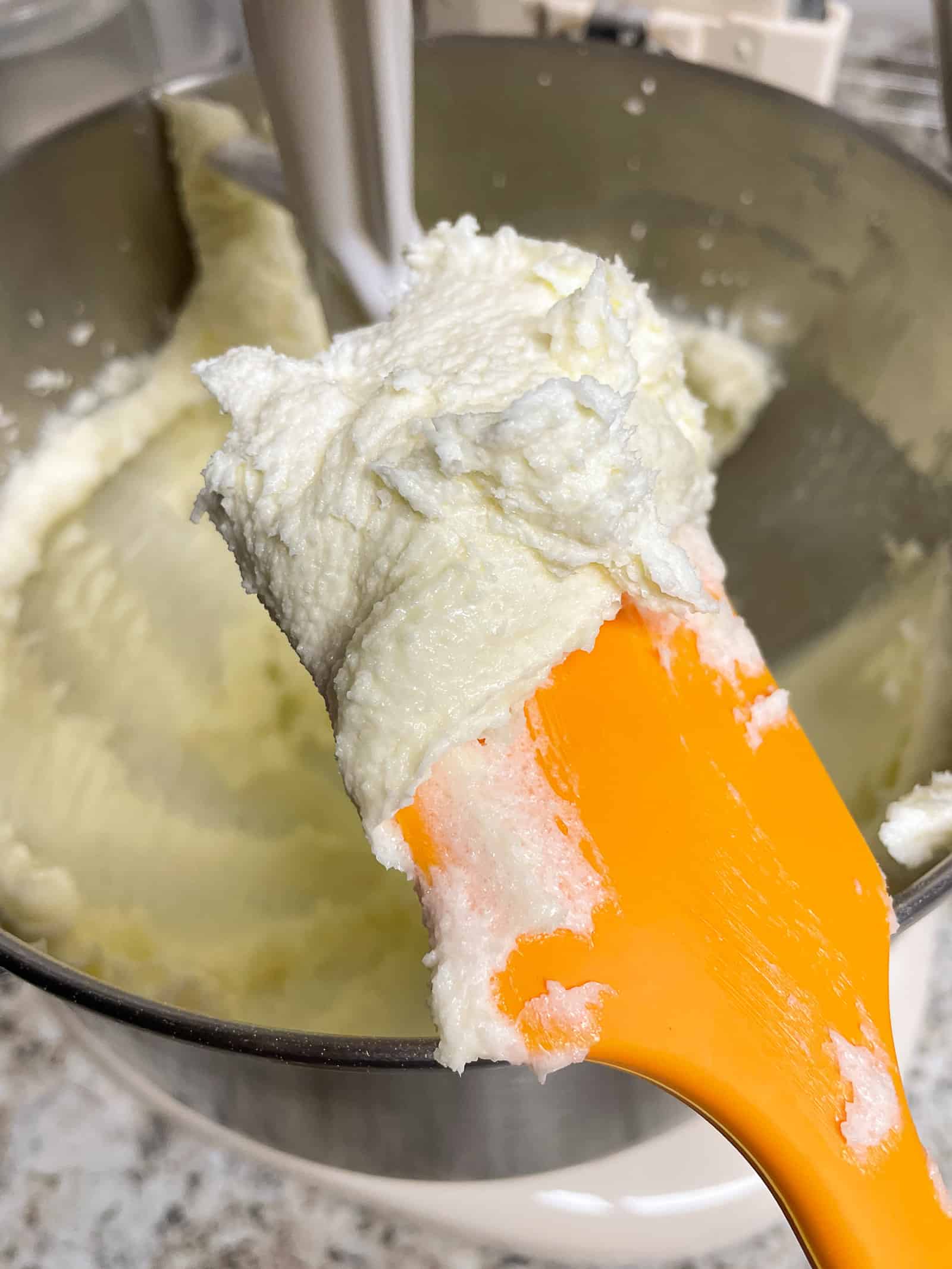
2. Mix the Sugar Until Creamy, Not Fluffy.
The texture of shortbread cookies is one of the things that sets them apart from other butter-based cookies. It’s dense and almost sandy. To achieve this lovely texture, blend the butter with the sugar until it’s thick, not fluffy. If the butter-sugar mixture gets fluffy, like it does for gluten-free pound cake, it traps air. That’s what makes it fluffy. That air causes the cookies to puff and rise, which we don’t want.
Simply mix the room-temperature butter with the sugar and salt until its thick and creamy. This only takes about a minute. It’s a good idea to stop the mixer once and scrape the sides of the bowl. There’s usually a thick layer of butter clinging to the bowl. Mix this in so there aren’t streaks of butter in the finished cookies.
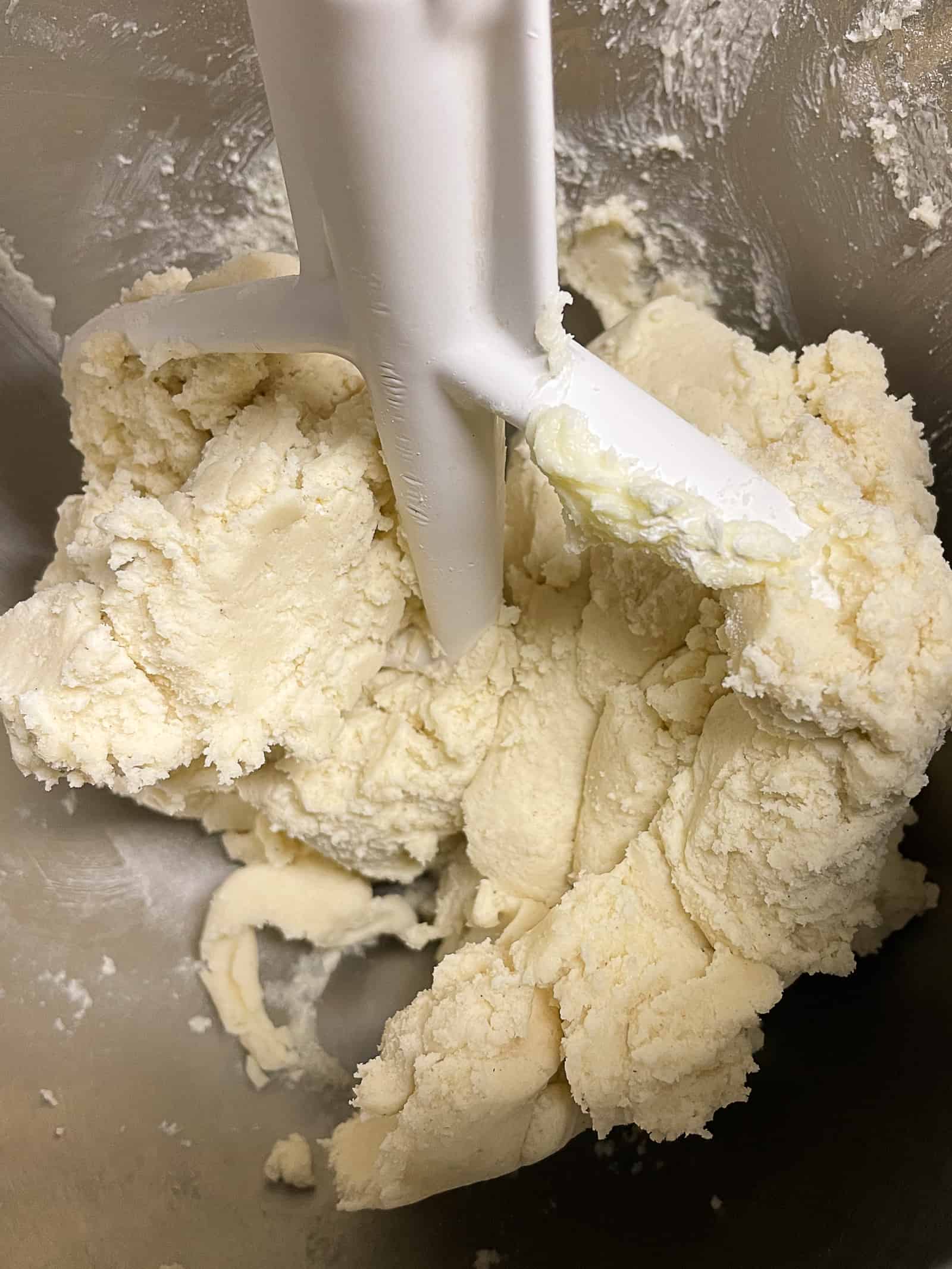
3. Make the Dough.
Since these cookies contain no eggs or liquid ingredients, there’s no moisture to coax the ingredients quickly into a dough. Once the dry ingredients are added to the butter and sugar, it takes a minute or so for a dough to form.
Gluten-free shortbread dough mixed in a stand mixer comes together differently than if mixed with a handheld mixer.
Baker’s Note: How to Make Gluten-Free Shortbread Dough with a Handheld Mixer.
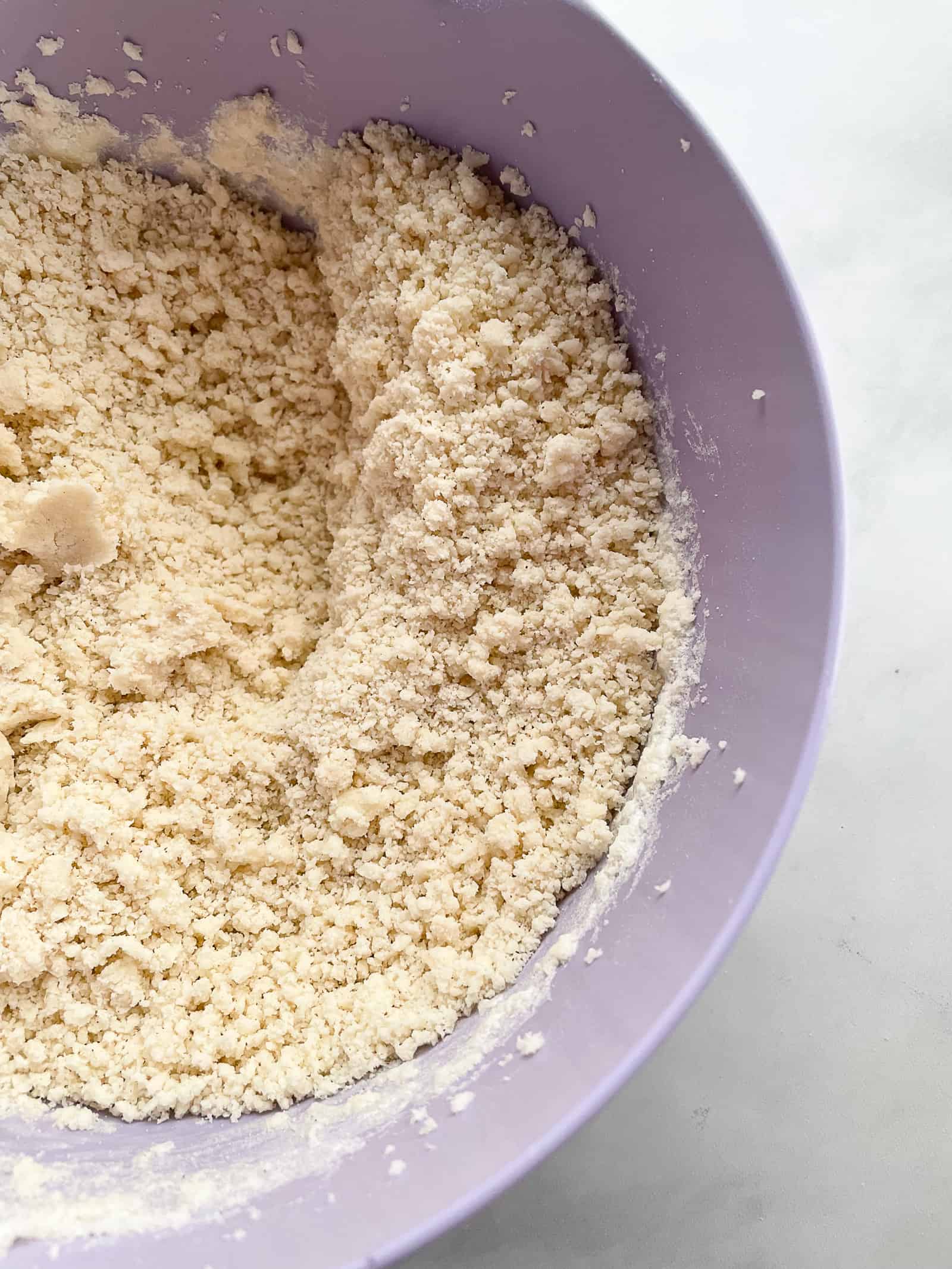
Shortbread dough can look incredibly crumbly and refuse to come together when you use a handheld mixer. This happens because of the shape of the beaters and the power of the mixer. In fact, if you’re using a handheld mixer, you might think there’s something wrong with the recipe at this point.
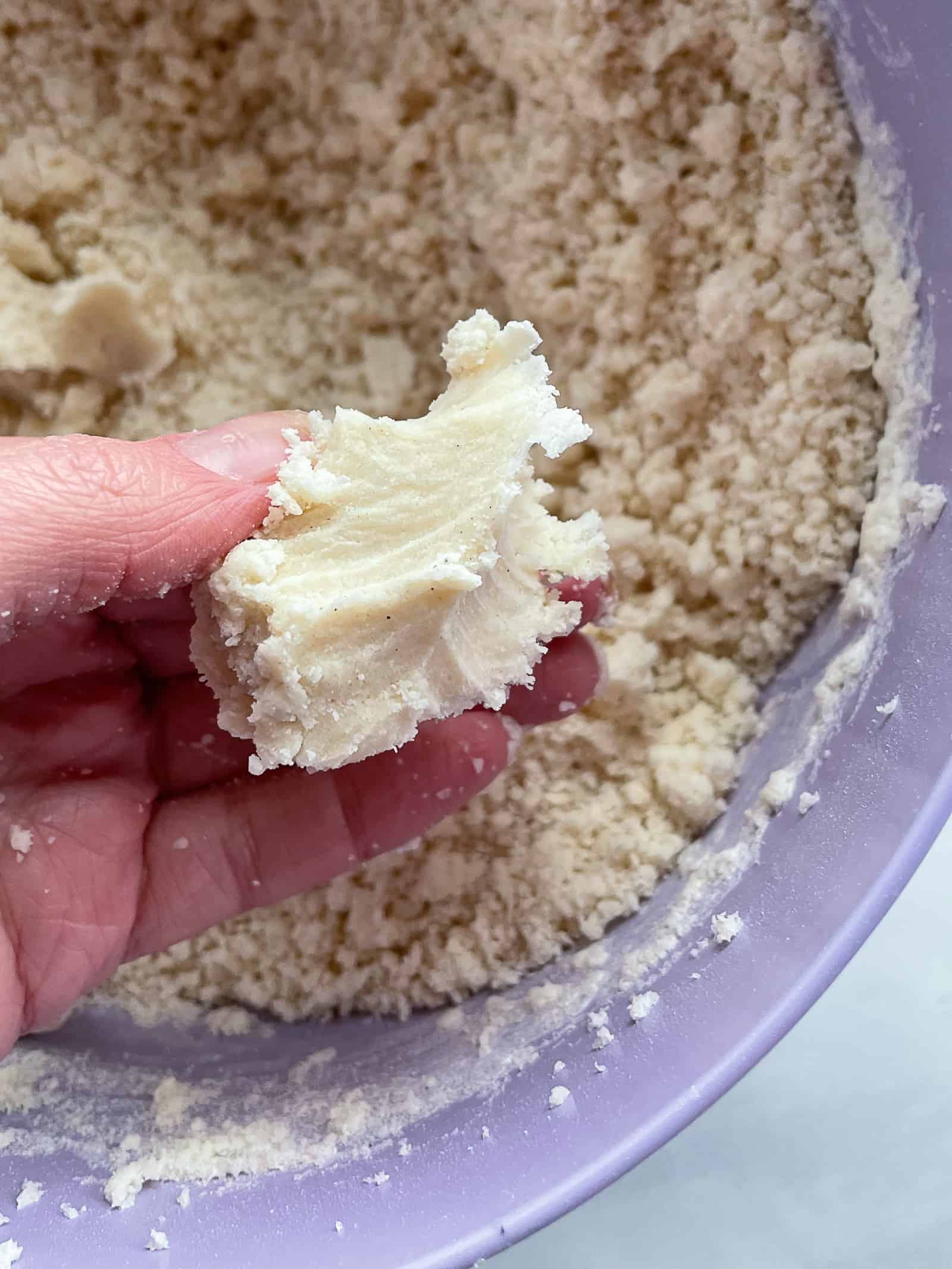
If you’re using a handheld mixer and you notice the dough is sandy or crumbly, stop the mixer. Give the dough a squeeze. If it easily holds its shape, stop using the mixer. Press the dough into a ball with your hands or a rubber spatula. I do this right in the mixing bowl. You can also turn the dough onto a lightly floured counter and knead it a few times.
If you squeeze the dough and it doesn’t hold its shape, add one teaspoon of water. After you add the water, the dough still might appear crumbly. That’s fine. Give it a squeeze. It should come together.
The exception to this is if the butter is very cold. If the dough is cold, let it warm up and try mixing again.
4. Shape the Dough.
From baking the cookies right in a pan to using your favorite cookie cutter, you’ve got options when it comes to shaping these cookies.
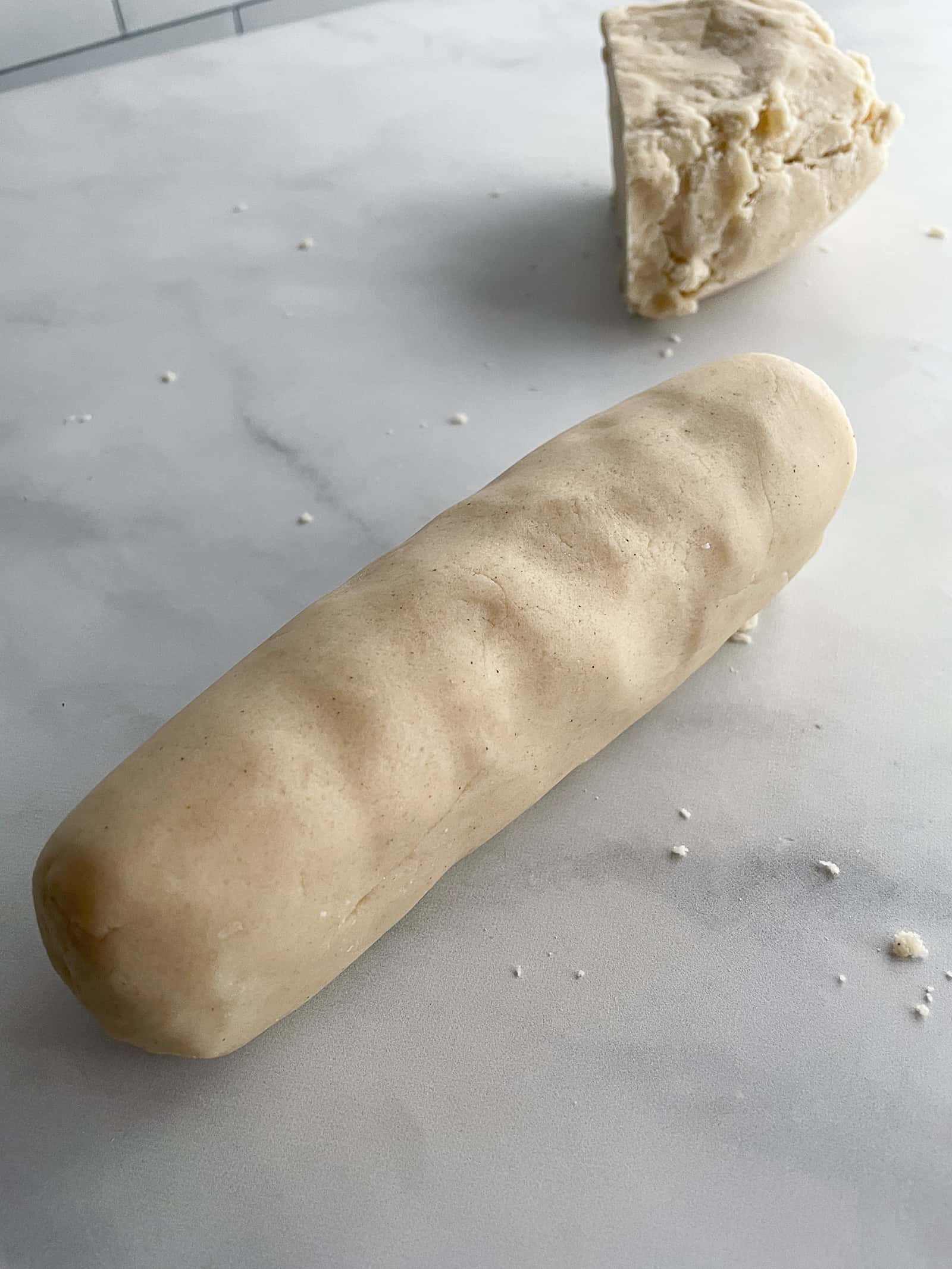
Roll into a log.
To make “slice and bake” shortbread cookies, divide the dough in half. Roll into a log about 2 to 2¼ inches across. Cut into rounds. If the dough crumbs when you cut it, gently press it into a round on the cookie sheet.
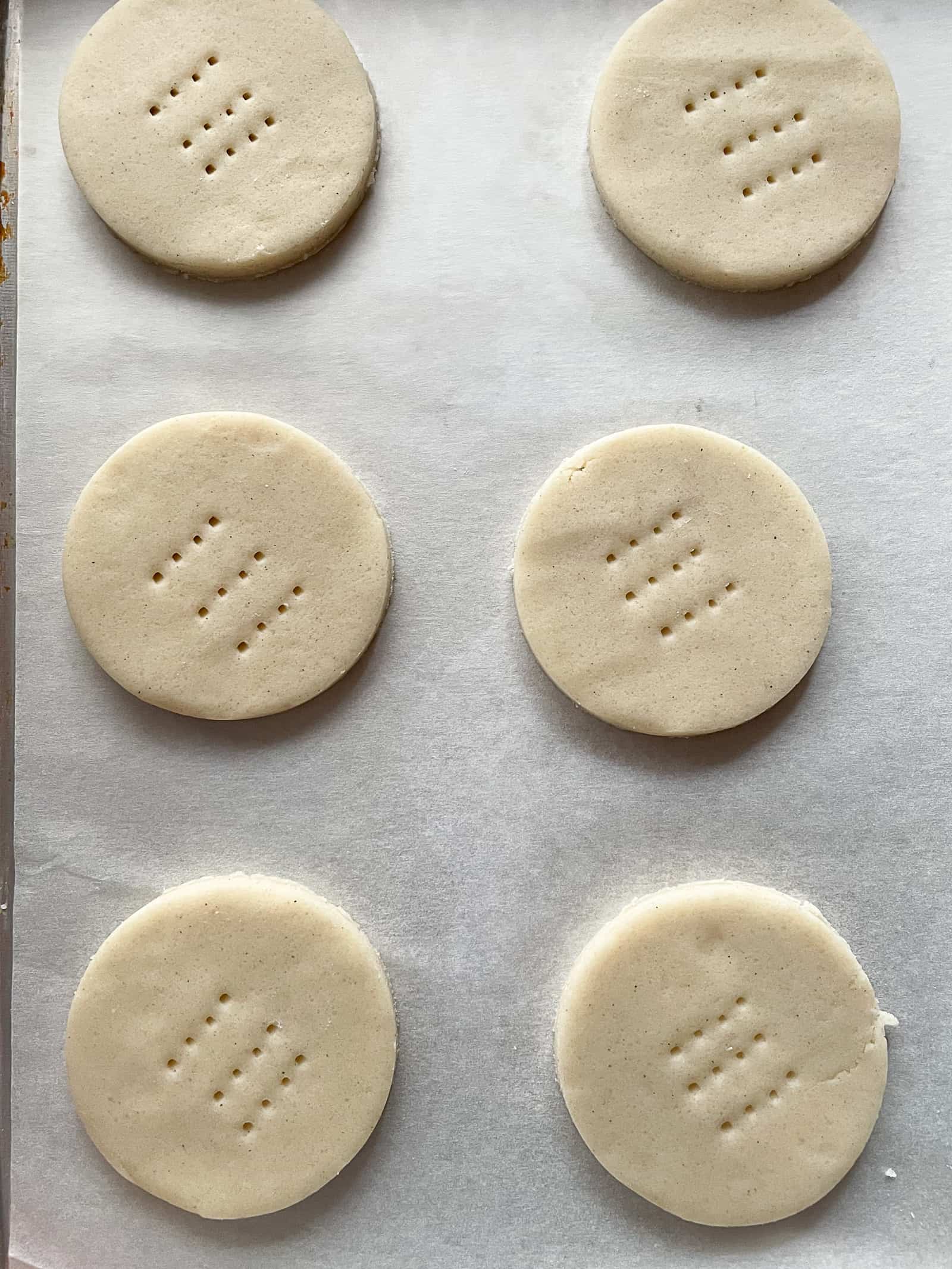
Use a Cookie Cutter.
You can use cookie cutters with this dough. Since it spreads a little during baking, basic shapes, like rounds, rectangles, and stars work best. To use a cookie cutter, dust your counter with gluten-free flour. Roll the dough out to about 1/4-inch thick. Dip your cutter in gluten-free flour and cut.
After cutting out the shapes, gather the remaining dough and re-roll. Since these cookies are gluten-free, they won’t get tough when re-rolled. If you notice the dough is warm after working with it, chill for 20 minutes before re-rolling.
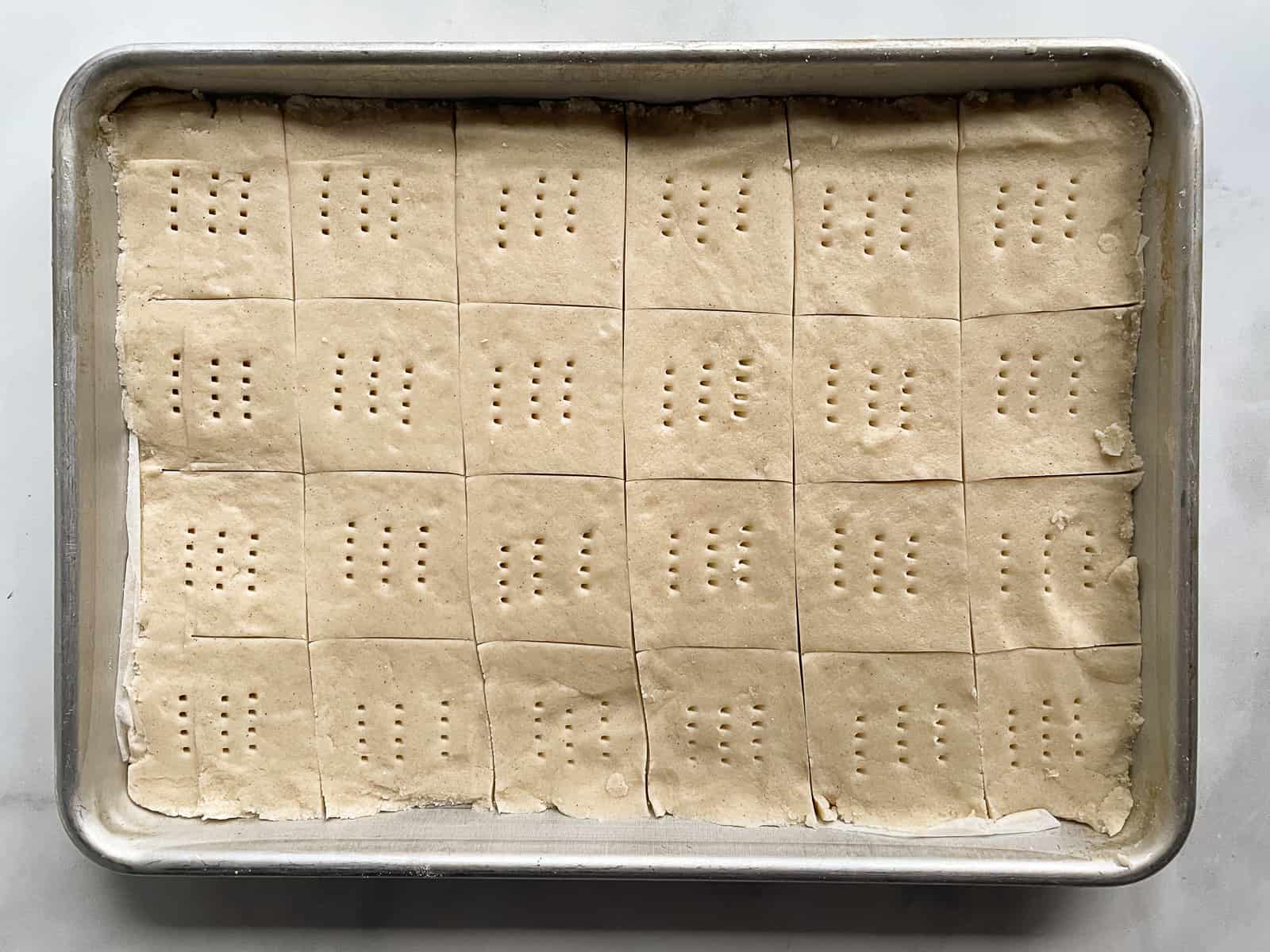
Bake in a Pan.
The easiest way to shape shortbread cookies is to press the dough into a 9×13-inch pan or two 8-inch round cake pans.
Line the pan(s) with parchment paper and grease the sides lightly with nonstick spray. Press the dough evenly into the pan. Score the dough into shapes. I like to make rectangles in the 9×13 inch pan and triangles if I use a round pan. This makes it easy to break the cookies apart after baking.
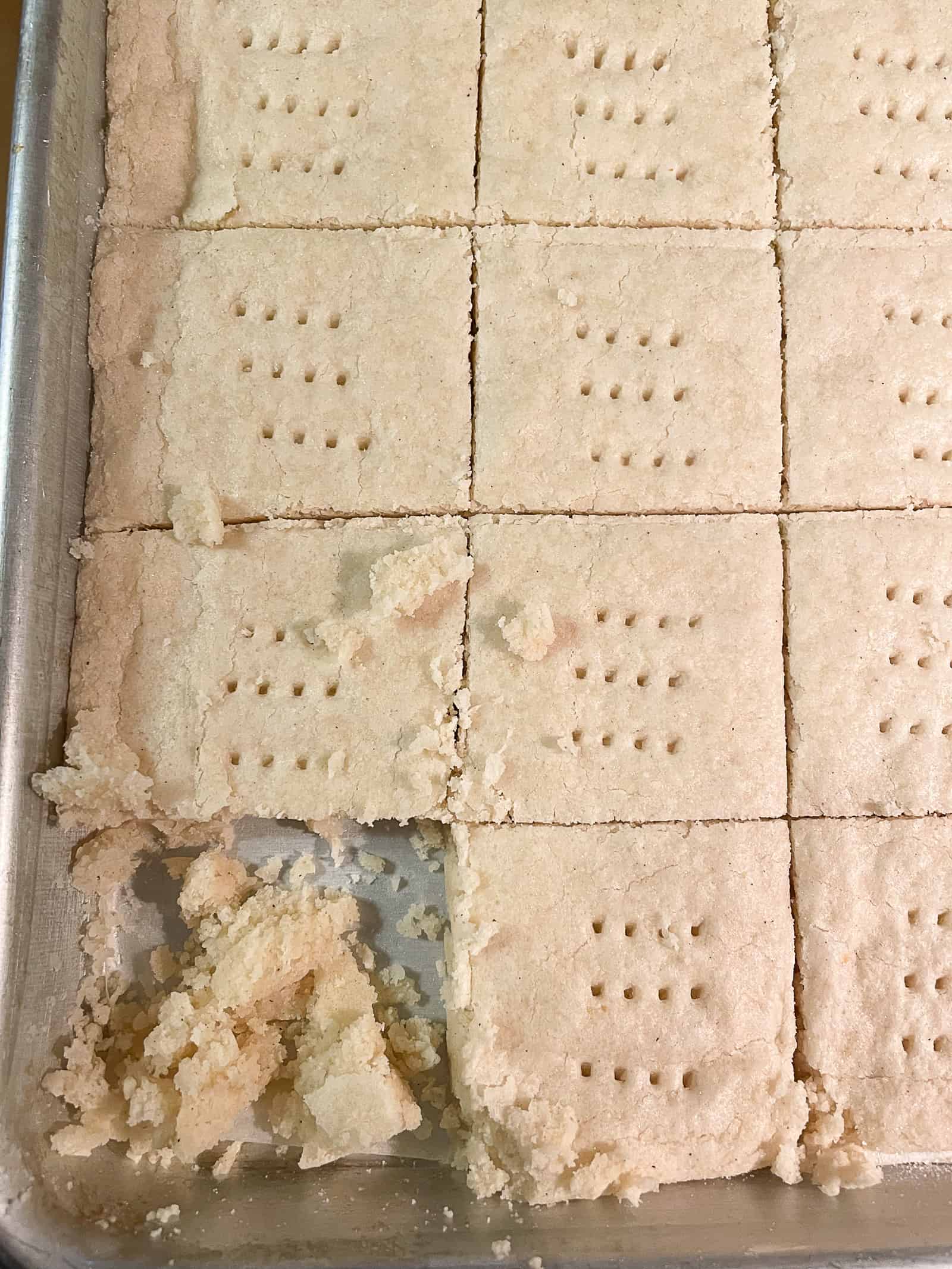
After baking, let the cookies cool in the pan. If you try to move them or cut them right after baking, they’ll crumble.
5. Poke Before Baking.
Whatever method you use to shape the cookies, it’s important to poke the tops gently with a fork. These tiny holes help the steam to escape during baking and keep the cookies from bubbling. To do this, press a fork gently into the tops of each cookie. There’s no need to press all the way through the dough. This might crack it. Instead, press the fork about halfway through the dough.

6. Bake Until Set
Shortbread cookies are baked at a lower temperature than most cookies. This low temperature keeps the cookies pale in color and gives them that delicate texture.
So how do you know when the cookies are done? Look for the edges to be a very light brown. The cookies should look set. If they seem shiny or appear dough-like, bake them a little longer. Small hairline cracks often appear on the surface of gluten-free shortbread cookies. This is normal and nothing to worry about.
7. Cool.
Cooling is an important step for these cookies. Since they’re so buttery, they can crumble when warm. If you make individual cookies, transfer them to a wire rack to cool. If you bake your shortbread in a pan, cool them in the pan for at least 30 minutes and then remove them.
Variations.
- Gluten-Free Lemon Shortbread. Add the zest of one lemon and one teaspoon of lemon extract to the dough.
- Gluten-Free Chocolate Chip Shortbread. Replace the granulated sugar with half granulated sugar and half light brown sugar. Add 6 ounces, about one cup, of chocolate chips or chopped dark chocolate.
- Gluten-Free and Dairy-Free Shortbread. For a gluten-free and dairy-free shortbread, replace the butter with your favorite dairy-free butter for baking. If the dough seems too soft, add a tablespoon or so of additional gluten-free flour and chill the dough for 30 minutes before baking.
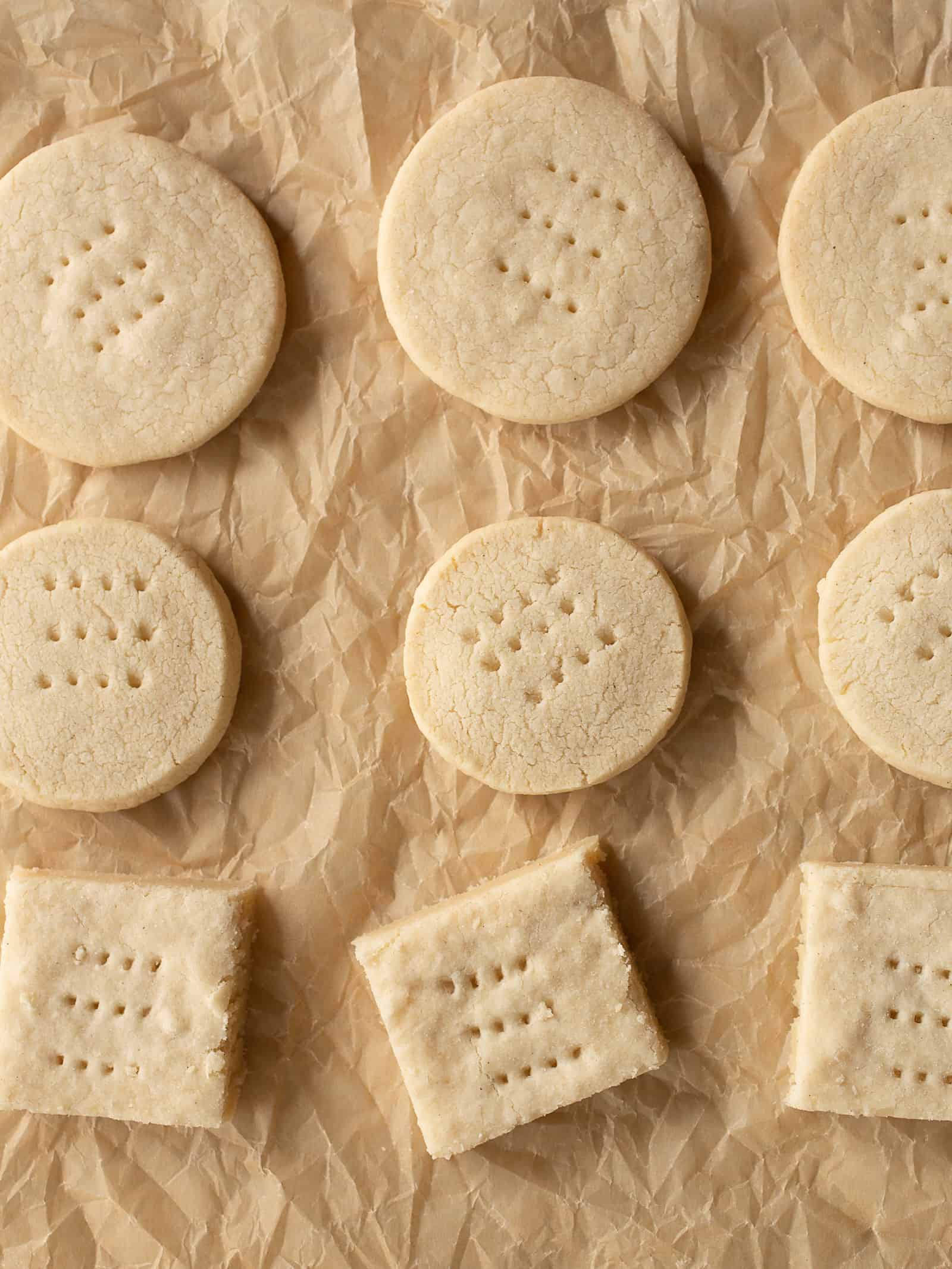
How to Store Gluten-Free Shortbread
Gluten-free shortbread dough and cookies are good “keepers.” Here’s how to make them in advance and store them.
How to Store Shortbread Dough.
You can make the dough ahead and store it, tightly wrapped in plastic wrap, for up to one week in the refrigerator, or 2 months in the freezer.
Gluten-free shortbread dough gets very hard when stored in the refrigerator. Let it come to almost room temperature before rolling or it will crack. You can cut the cookies into rounds before storing them. If you do, remove the cookies from the refrigerator, place them on a parchment-lined baking sheet and bake them in a preheated oven.
How to Store Baked Gluten-Free Shortbread Cookies.
To store at room temperature: Place the cooled cookies in an airtight container. They keep at room temperature for up to 5 days.
To freeze the cookies: place them into a freezer container. You can separate layers with a piece of parchment or waxed paper. Freeze the cookies for up to two months.
To thaw the frozen dough or cookies: place on the counter for several hours.
Solving Common Gluten-Free Shortbread Problems.
My cookie dough isn’t coming together, what do I do?
- Give it a squeeze. If your dough looks crumbly but easily holds together when squeezed, press it into ball with your hands or a sturdy spatula. Some mixers aren’t strong enough
- Check the temperature. Cold gluten-free shortbread doesn’t come together easily. If your dough feels cold to the touch, let it warm for about 20 minutes and then try mixing again.
- Add a tiny bit of water. If you’ve checked numbers one and two and the dough still won’t come together, stop your mixer and add two teaspoons of water. This should help it come together.
Note: If after checking the butter temperature and adding water, the dough still won’t come together, I’d check how much flour you added. If you accidentally added too much, the cookie dough will remain too dry.
The shortbread dough is very soft and hard to roll/shape.
If your dough is sticky and hard to roll, feel it. If the dough feels warm or at room temperature, cover it and chill it in the refrigerator for 30 minutes. If the dough feels cool, add a tablespoon of additional gluten-free flour.
The dough is firm and hard to roll.
If your dough is cracking and hard to roll, cover it and let sit for 20 minutes. It might be too cold. If that doesn’t fix the problem, add a teaspoon of water and mix until a dough forms.
The Cookies Spread.
These shortbread cookies should hold their shape during baking. If they spread into thin cookies, a few things could have happened.
- The butter might have been too warm. If you make the dough with very soft butter or the dough warms up (gets squishy) before baking, the cookies can spread.
Next time, keep the butter at room temperature. If the dough gets warm before baking, chill it for about 15 to 20 minutes before baking the cookies.
- Too much liquid was added. More than about two teaspoons of liquid can cause the cookies to spread.
- The gluten-free flour. Each brand of gluten-free flour bakes differently. I tested this recipe with Bob’s Red Mill 1:1 Gluten-Free Baking Flour. Be sure your blend contains xanthan or guar gum. This is key to helping the cookies hold their shape.
- Measuring mistake. It happens to even the best baker: a measuring error. If the cookies didn’t have enough flour or contained too much butter, they will spread.
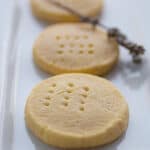
Gluten-Free Shortbread
This gluten-free shortbread recipe makes cookies that are rich and flavorful. The texture is wonderful: slightly crumbly in the best way. The cookies are egg-free and can be made dairy-free.
Ingredients
- 1 cup butter, softened (about 68℉) (2 sticks; 8 ounces; 198 grams)
- 1 teaspoon salt
- ¾ cup granulated sugar (5 ¼ ounces; 148 grams)
- 1 teaspoon vanilla extract
- 1 ½ cups gluten-free flour blend, see note (12 ounces; 345 grams)
Instructions
-
Preheat oven to 325°F.
-
Combine softened butter, granulated sugar, and salt in the bowl of a stand mixer or in a large mixing bowl.
Mix until thick and creamy, about one minute. Use high speed with a handheld mixer and medium-high speed on a stand mixer.
Stop the mixer and scrape the bottom and sides of the bowl. Add the vanilla extract. Mix for an additional minute. Add the gluten-free flour.
-
Stand Mixer directions: mix for about two minutes on medium-high speed. Be sure to use the flat paddle attachment.
Stand mixer directions: Mix on high speed. If the dough seems crumbly after two minutes, stop the mixer. Squeeze the crumbs. If they hold together, press the dough into a ball with your hands or a sturdy rubber spatula. If the dough does not hold together when squeezed, see note below.
-
Shape the Dough.
For slice and bake cookies: divide the dough in half. Dust your counter with gluten-free flour. Knead the. dough a few times until smooth. Then roll out into a log, about 2 inches in diameter. Use a sharp knife and cut into rounds, about ½-inch thick. Place the cookies onto a parchment-lined baking sheet, about 1 inch apart.
For cut-out cookies: Lightly white rice flour your countertop. Turn dough out onto counter and shape dough into a disk. Using a rolling pin, roll dough out, about ½-inch thick.
Cut into shapes. Dip your cutter into gluten-free flour to keep the dough from sticking to the cutter. Place the cookies onto a parchment-lined baking sheet, about 1 inch apart. Gently knead leftover dough into a ball and re-roll. If the dough gets warm, chill it for about 20 minutes.
For a pan of cookies: Lightly grease one 9×13-inch pan or two 8-inch round pans. Line with parchment paper. Press dough evenly into the pan. Score into 24 cookies for the 9×13-inch pan and cookies and about 8 triangles each for the 8-inch round pans.
-
Poke small holes into the tops of each cookie. Do this for the slice and bake, cutouts, and pan of cookies. You want about three rows of holes per cookie.
Bake until the cookies are set, about 35 minutes. Look for the edges to be lightly golden brown.
Transfer individual cookies to a wire rack. For a pan of cookies, allow the cookies to cool right in the pan.
-
Store cookies in an airtight container for up to one week. Or freeze the cooled cookies for up to two months in a freezer container.
Recipe Notes
Gluten-Free Flour.
Use a gluten-free flour blend that contains xanthan gum. If your blend doesn’t contain xanthan gum, whisk ¼ teaspoon into the flour before using.
How to Fix Crumbly Dough.
If your dough is crumbly and isn’t coming together, here’s how to fix it:
- Give it a squeeze. If your dough looks crumbly but easily holds together when squeezed, press it into ball with your hands or a sturdy spatula. Some mixers aren’t strong enough
- Check the temperature. Cold gluten-free shortbread doesn’t come together easily. If your dough feels cold to the touch, let it warm for about 20 minutes and then try mixing again.
- Add a tiny bit of water. If you’ve checked numbers one and two and the dough still wont’ come together, stop your mixer and add two teaspoons of water. This should help it come together.
Note: If after checking the butter temperature and adding water, the dough still won’t come together, I’d check how much flour you added. If you accidentally added too much, the cookie dough will remain too dry.


Katherine Lambertson says
I have made these twice this year and instead of getting shortbread I get sugar pancakes. I have tried refrigerating dough etc and the same result. I saw that in a note above there was Baking soda mentioned but the recipe doesn’t have that listed as an agreement?
Elizabeth says
I’m sorry that happened. What gluten-free flour did you use?
Diane B says
I made these with King Arthurs measure for measure gluten free flour and light brown sugar. I weighed the flour. They turned out very well. Thank you- it’s been challenging to switch to gluten free baking. I will make this recipe again.
Nope says
35 minutes??? At 325???
I should’ve known butter.
Cookies were disgusting and burnt.
Elizabeth says
Yes. If they baked faster, perhaps the cookies were rolled a thinner than 1/2-inch?
Suzie says
I love this recipe. I used it when it wasn’t listed with Bob’s flour.
I’m trying to work out the rice flour, cornflour & sweet rice amounts.
I’m guessing from the comments & video that it’s
1 1/3 cups rice flour
1 cup cornflour &
1 cup sweet rice flour.
Thanks for your hard work Elizabeth, it’s much appreciated.
Kathy says
Loved this recipe. Made thick stars for a cookie Christmas tree and turned out beautifully. Thank you for sharing. K
Gill L. says
Wow, a lot of firsts with this recipe. First, I made shortbread cookies for the first time. Second, I made Gluten Free cookies of any kind for the first time. Third, I made roll and slice cookies for the first time. Fourth, I weighed all my ingredients instead of using measuring cups for the first time. These cookies are AMAZING. My GF daughter was missing our traditional Not Yo Mama’s Banana Pudding and found this recipe and asked if we could make these instead of using chessman cookies. They were BETTER! They have become my husband’s favorite. My GF sister couldn’t keep out of the jar at Christmas. They were PERFECT. Oh, I used Bob’s Redmill GF 1 to 1 baking flour. No issues, worked like a dream. And I sprinkled them with sugar prior to baking.
Deb H says
Made this recipe at 172ft altitude down in New Zealand using Nz Butter (which is pretty close to the Irish butter I used to buy at wegmans in the USA). I used the Yummly ingredients list with white rice flour, mochiko sweet rice flour, cornstarch, xanthan gum and baking powder- you have different ingredients listed on this glutenfreebaking.com website but the Yummly website links to this recipe so it is meant to be used with these instructions. The butter was tiny but warm at room temp so I put in fridge for 10 mins, it’s summer here, I used raw sugar granulated, dough crumbled and used fingers to work the butter through, then pressed into a 9 x13 inch tree glass dish, about 1/4 inch thick- I cut the fingers of shortbread shape I wanted, pricked with fork and cooked at 162°C which is 325°F for 35 mins, wasn’t long enough for the very slightly thicker parts so needed another 10-12 mins longer. Left in pan to cool. Came out of dish carefully, a couple have broken in half but most have stayed complete, has passed hubby and children 6 and 8 yrs old tested and a gluten eating grandfather. Thank you for this recipe. I had all the ingredients so that is helpful you were so specific with the flours- it’s hard to find decent gf flour mixes/blends in other countries that do what you want them to do, so I have found it’s easier to just get the basic flours separately and blend myself. They have come out very well and I will be making more in the pan. They’re not too sweet and melt in the mouth. It’s seems the xanthan gum might be best to combat any melted messes- that’s what other gf recipes use too. These should be eaten pretty quickly so no worries about storing them. Thank you.🙏🏼